An Analysis of the Effect of Hall Thruster Plumes on Surface Charging of a Complex Spacecraft Structure
Abstract
Featured Application
Abstract
1. Introduction
2. Theoretical Models
2.1. Surface Charging Theory Model
2.1.1. Equation for Current Balance
2.1.2. Potential Solver
2.2. Geometric Models
2.3. GEO Environmental Model
3. Results
3.1. Impact of Thrusters on Surface Charging and Discharging Effects in Spacecraft
3.2. Impact of Thrusters at Various Locations on Spacecraft Charging and Discharging Effect
4. Conclusions
- With the Hall thruster closed, the glass and other areas are in the vicinity of the existence of a great potential difference, about 3740 V. This region is highly susceptible to electrostatic discharge phenomena, necessitating a certain level of protection to prevent discharges that could impact the performance of nearby payloads.
- The Hall thruster plume has a major effect on the spacecraft surface charging potential, while the influence of the space environment has less of an effect on the surface potential, which is mainly affected by the charge exchange ions in the plume.
- The position of the thrusters has almost no effect on the overall surface charging of the satellite, and the surface charging potential of Position 2, where the thrusters are located closer to the main body of the spacecraft, is only 1.3 V higher than the surface charging potential of Position 1. However, when the thruster is in Position 2, more CEX_Xe+ is attracted to the spacecraft surface, which results in a greater deposition contamination of the spacecraft surface.
- The spacecraft surface potential appears to be the maximum value of the glass surface; by their own shade, not light and poor conductivity of the material, the emission of photoelectrons is inhibited so that the surface potential of the charge moves to a higher position.
Author Contributions
Funding
Institutional Review Board Statement
Informed Consent Statement
Data Availability Statement
Acknowledgments
Conflicts of Interest
References
- Tirila, V.G.; Demairé, A.; Ryan, C.N. Review of alternative propellants in Hall thrusters. Acta Astronaut. 2023, 212, 284–306. [Google Scholar] [CrossRef]
- Hang, G.; Li, S.; Kang, X.; Jin, Y.; Sun, W. Current Space Application Status and Future Prospect of Hall Electric Propulsion. J. Propuls. Technol. 2023, 6, 38–51. [Google Scholar] [CrossRef]
- Bapat, A.; Salunkhe, P.B.; Patil, A.V. Hall-effect thrusters for deep-space missions: A review. IEEE Trans. Plasma Sci. 2022, 50, 189–202. [Google Scholar] [CrossRef]
- Koons, H.C.; Mazur, J.E.; Selesnick, R.S.; Blake, J.B.; Fennell, J.F.; Roeder, J.L.; Anderson, P.C. The impact of the space environment on space systems. NASA STI/Recon Tech. Rep. N 1999, 69036–69041. [Google Scholar]
- Gupta, S.B.; Kalaria, K.R.; Vaghela, N.P.; Mukherjee, S.; Joshi, R.S.; Puthanveettil, S.E.; Shankaran, M.; Ekkundi, R.S. An overview of spacecraft charging research in India: Spacecraft plasma interaction experiments—SPIX-II. IEEE Trans. Plasma Sci. 2014, 42, 1072–1077. [Google Scholar] [CrossRef]
- Feng, N.; Li, D.; Yang, S.; Chen, Y.; Zhao, C.; Tang, D. Theory Study of Ion Thruster Plume to Spacecraft Surface Charging. High-Volt. Technol. 2016, 5, 1449–1454. [Google Scholar] [CrossRef]
- Garrett, H.B. The charging of spacecraft surfaces. Rev. Geophys. 1981, 19, 577–616. [Google Scholar] [CrossRef]
- Lieberman, M.A.; Lichtenberg, A.J. Principles of plasma discharges and materials processing. MRS Bull. 1994, 30, 899–901. [Google Scholar]
- Allen, J.E.; Annaratone, B.M.; de Angelis, U. On the orbital motion limited theory for a small body at floating potential in a Maxwellian plasma. J. Plasma Phys. 2000, 63, 299–309. [Google Scholar] [CrossRef]
- Sjogren, A.; Eriksson, A.I.; Cully, C.M. Simulation of potential measurements around a photoemitting spacecraft in a flowing plasma. IEEE Trans. Plasma Sci. 2012, 40, 1257–1261. [Google Scholar] [CrossRef]
- Filleul, F.; Sutherland, O.; Cipriani, F.; Charles, C. BepiColombo: A Platform for Improving Modeling of Electric Propulsion-Spacecraft Interactions. Front. Space Technol. 2021, 2, 639819. [Google Scholar] [CrossRef]
- Zheng, Y.; Zhang, Q.; Xiang, H.; Yao, S.; Zheng, Y.; Quan, L. Surface charging and dose monitor on geosynchronous orbit satellite. Open Astron. 2023, 32, 20220211. [Google Scholar] [CrossRef]
- Cho, M.; Sumida, T.; Masui, H.; Toyoda, K.; Kim, J.H.; Hatta, S.; Wong, F.K.; Hoang, B. Spacecraft charging analysis of large GEO satellites using MUSCAT. IEEE Trans. Plasma Sci. 2012, 40, 1248–1256. [Google Scholar] [CrossRef]
- Zhao, C.; Li, D.; Yang, S.; Qin, X.; Wang, J.; Chen, Y.; Tang, D.; Shi, L. Simulation of Surface Charging of Geosynchronous Orbit Spacecraft. Chin. J. Vac. Sci. Technol. 2014, 12, 1279–1284. [Google Scholar] [CrossRef]
- Secretariat, E.C.S.S. Space Environment. ECSS-E-10-04A 2008, ESA Publications Division [Internet]. 2000. Available online: www.spacewx.com/Docs/ECSS-EST-10-04C_15Nov2008.pdf (accessed on 29 January 2016).
- Xu, L.; Cai, M.; Yang, T.; Han, J. Surface charging effect of the satellite SMILE. ActaPhysica Sin. 2020, 16, 199–206. [Google Scholar] [CrossRef]

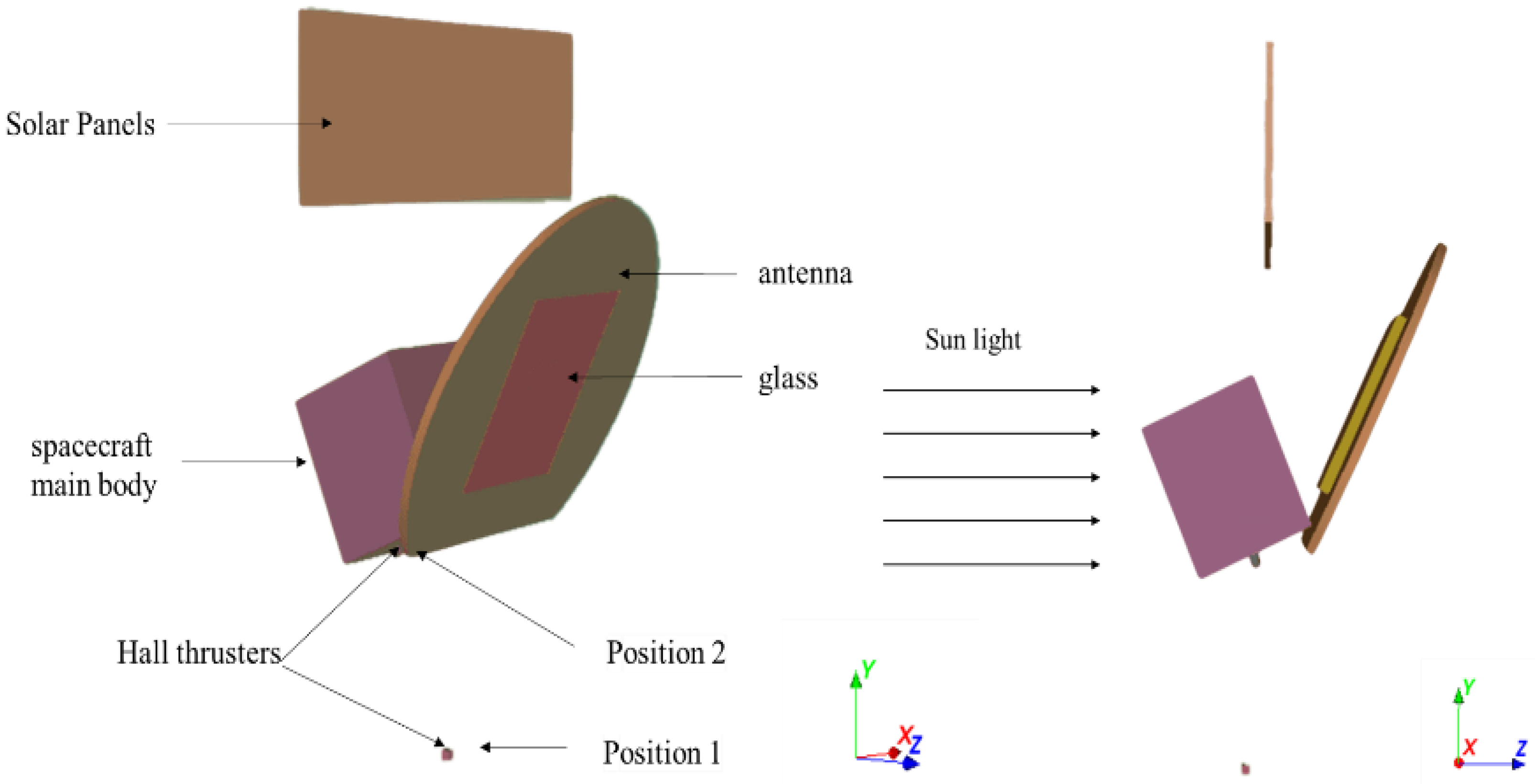

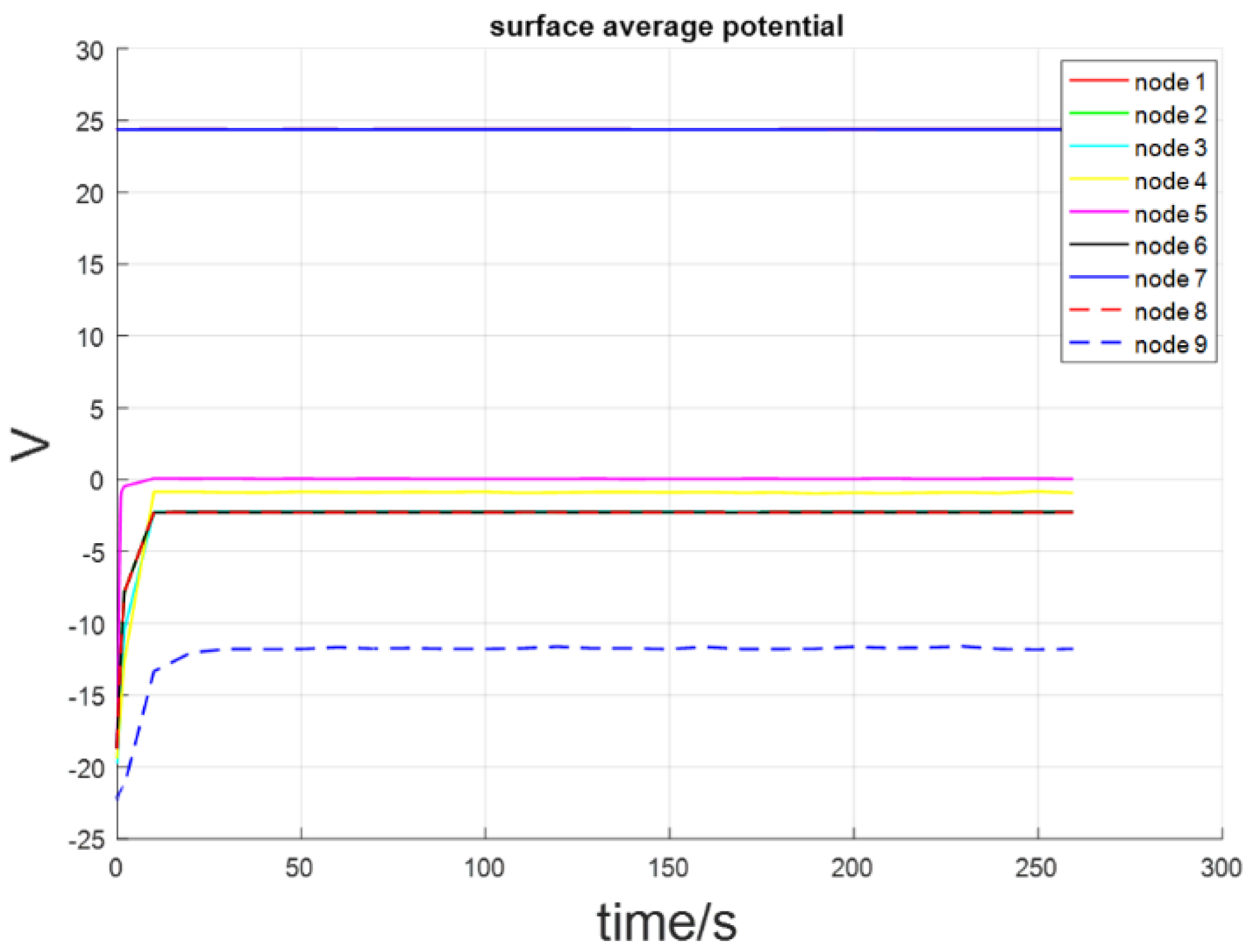
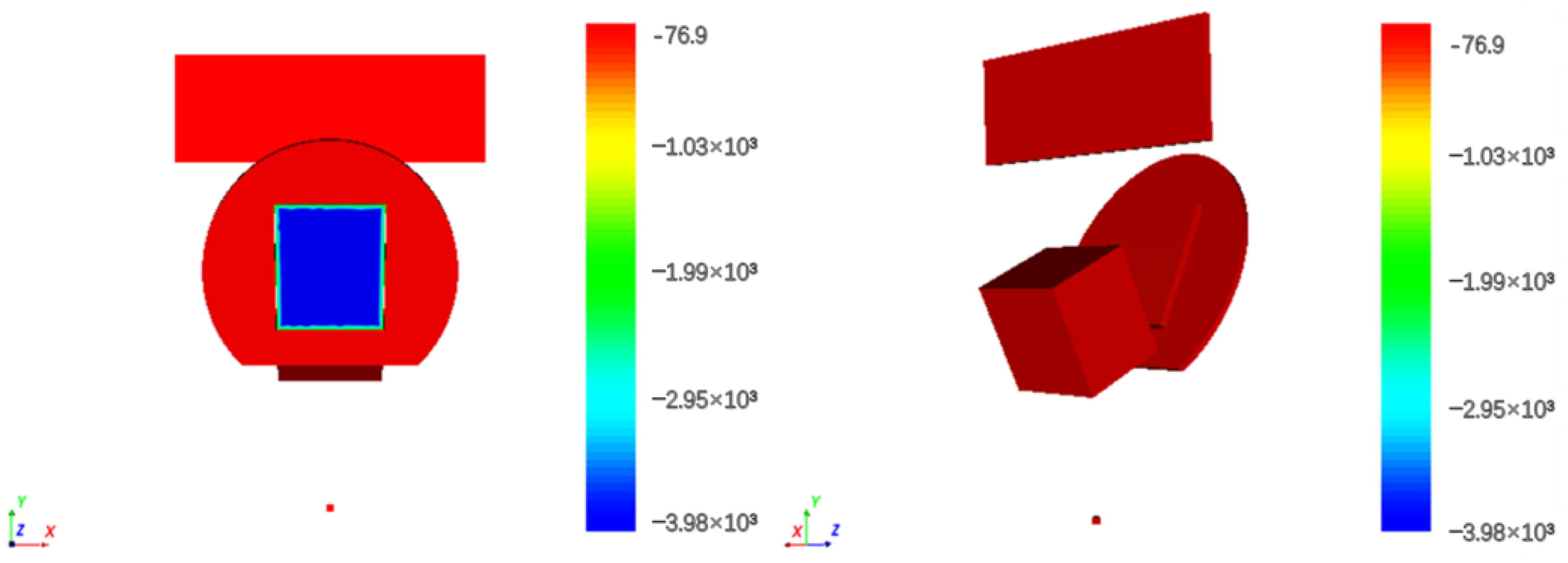
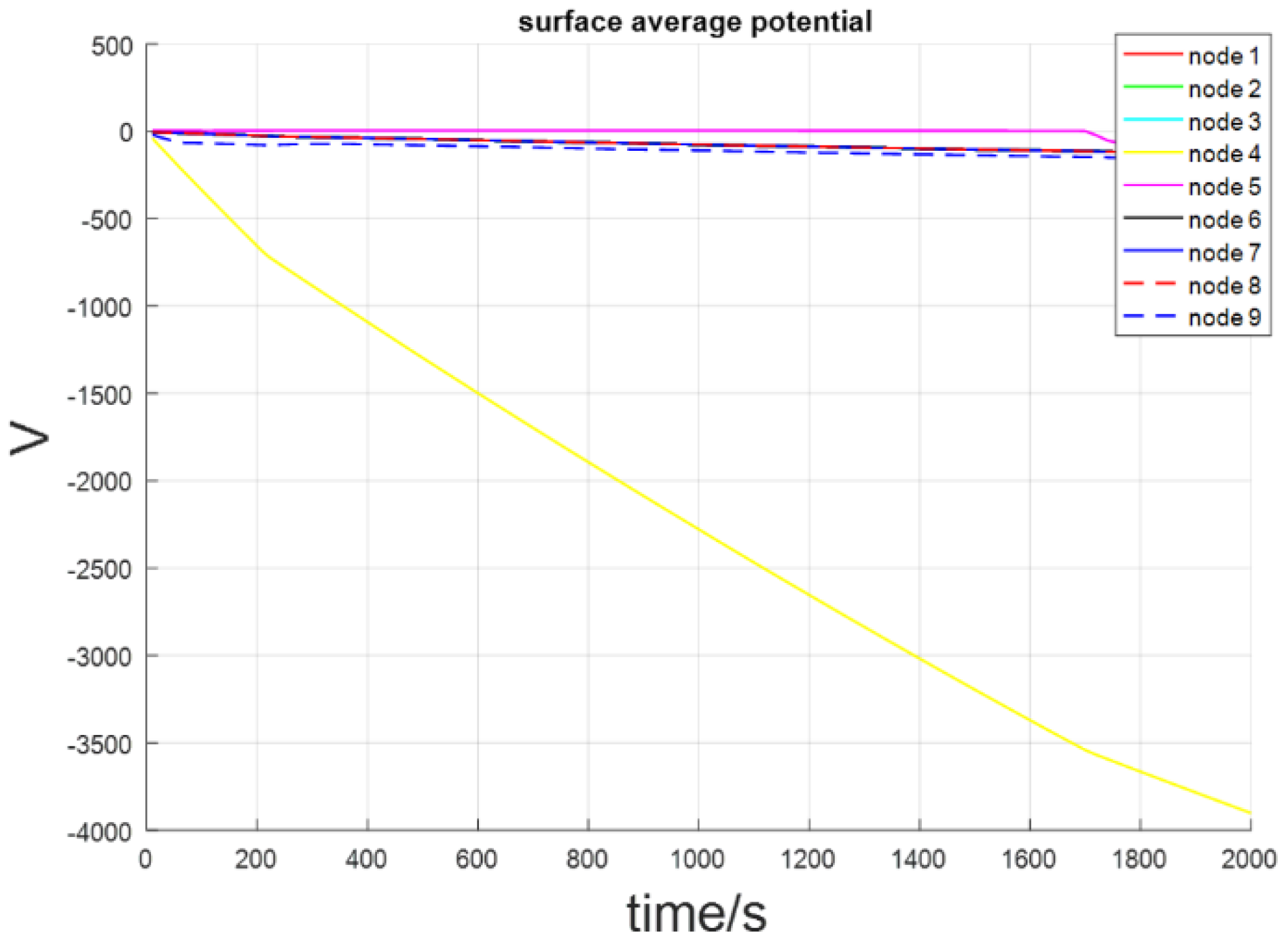
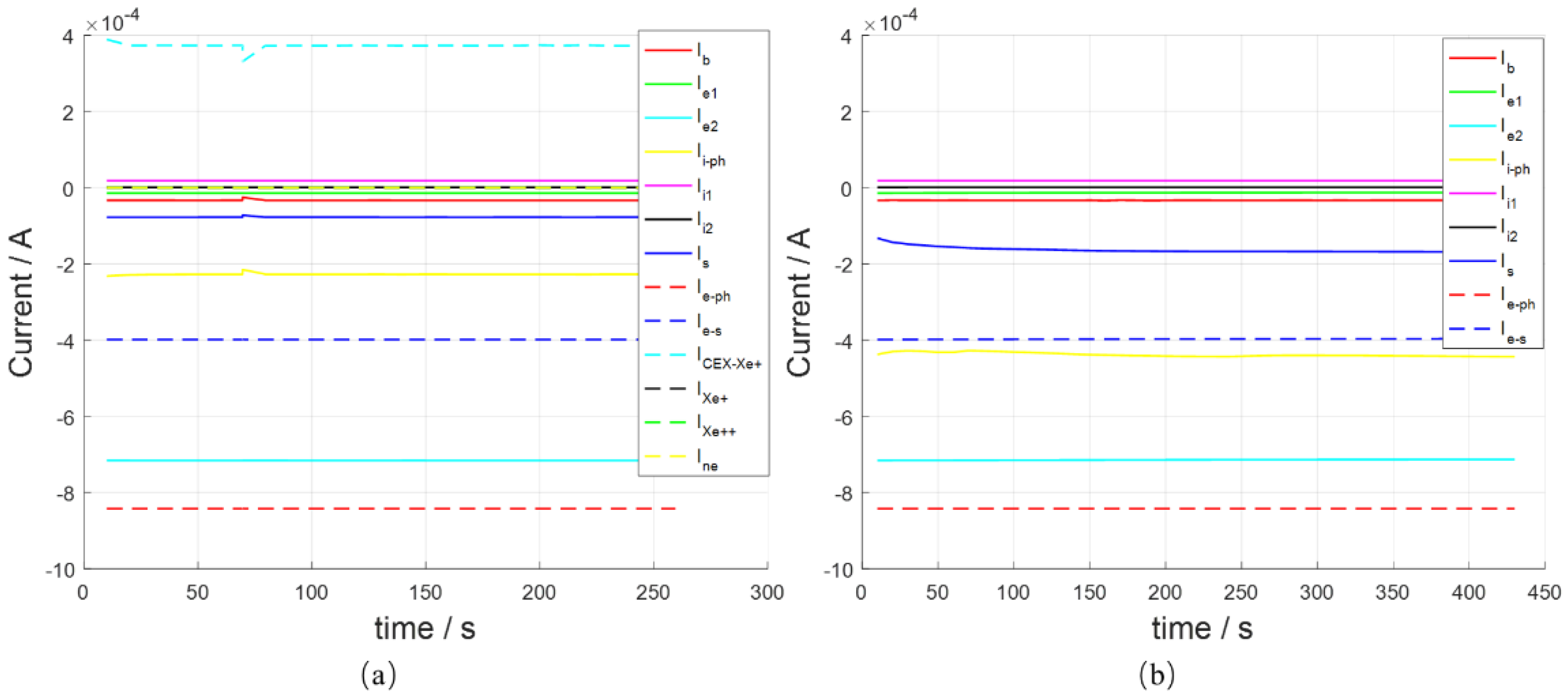
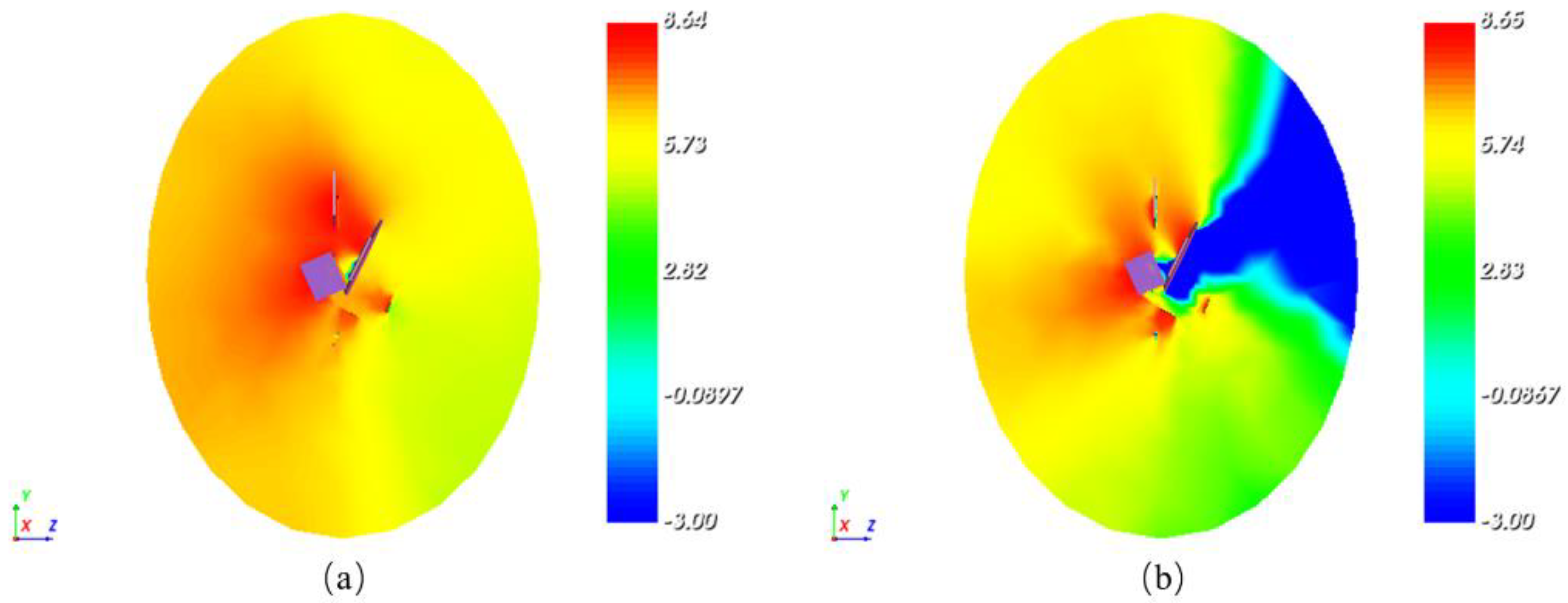
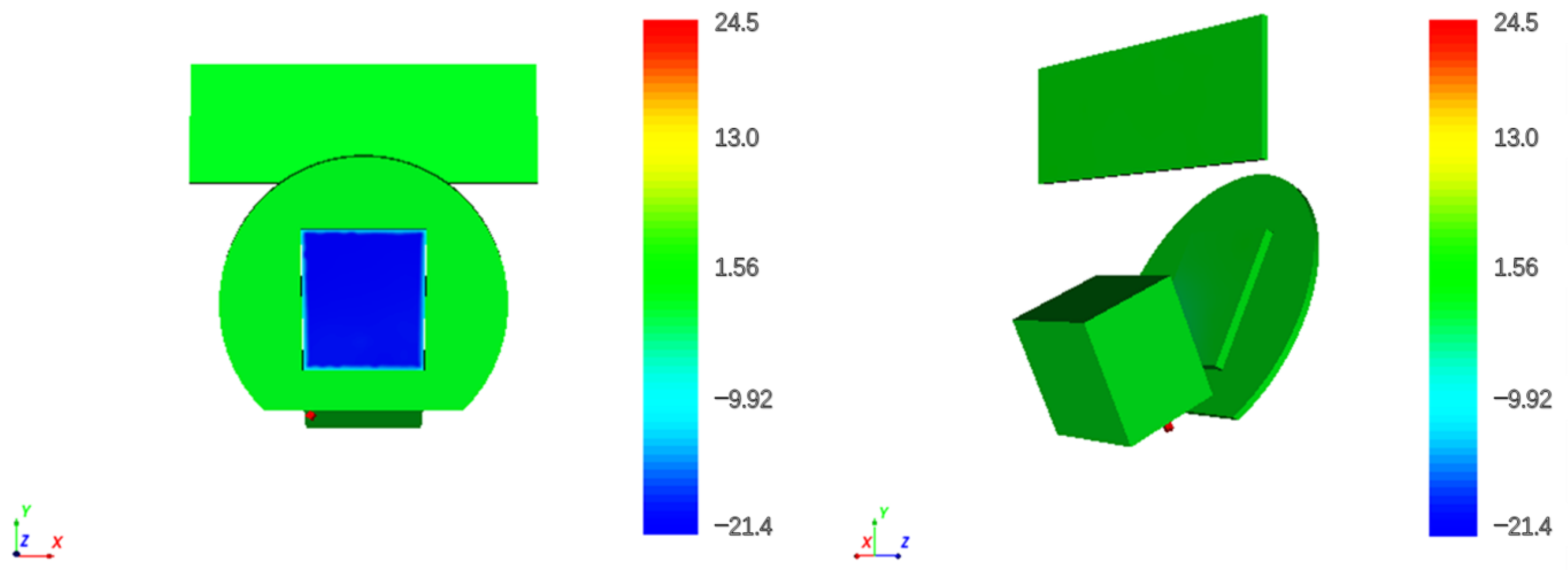


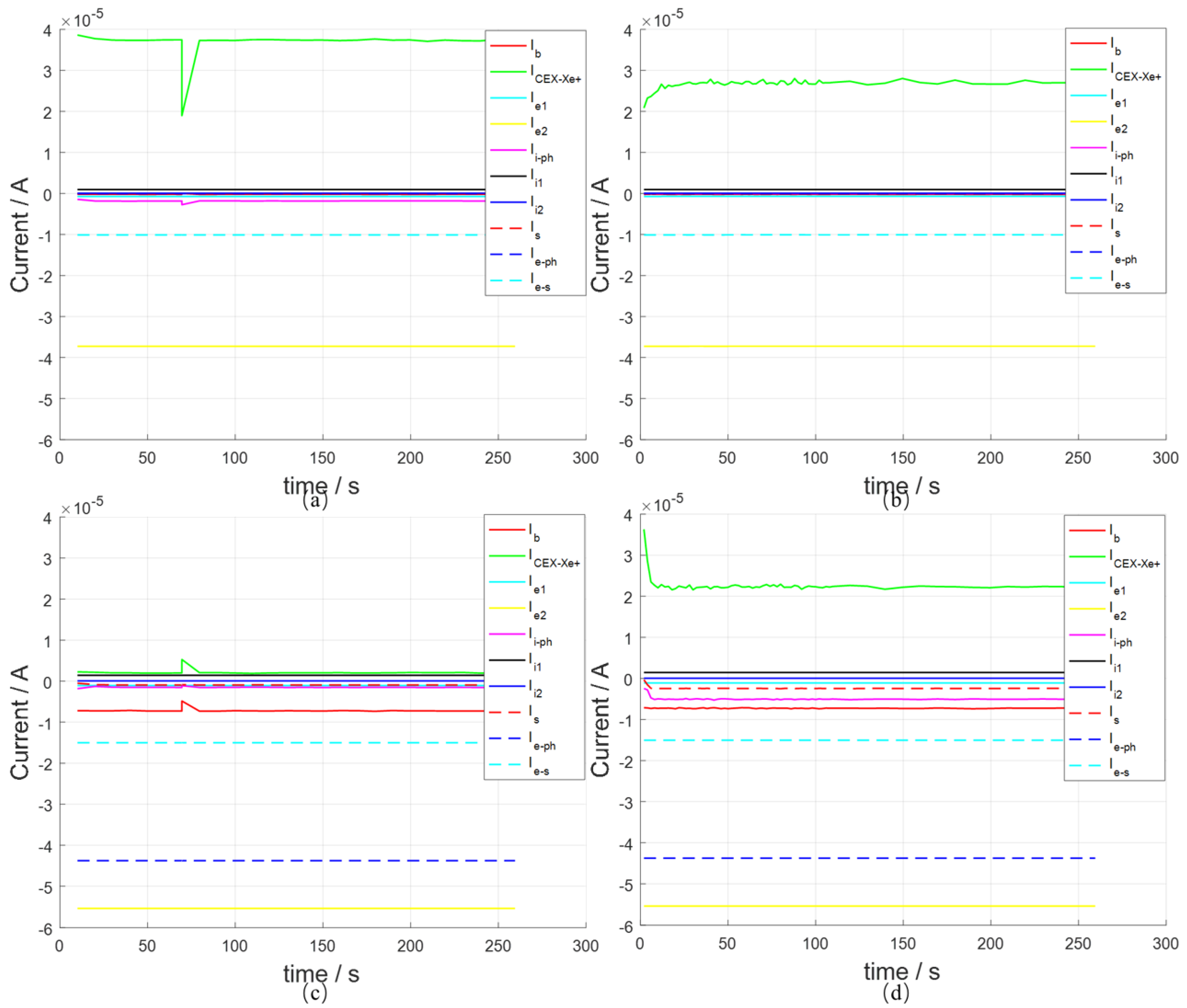
| Spacecraft Components | Nodes | Surface Materials | Connected Nodes | Equivalent Circuit |
|---|---|---|---|---|
| main body (bottom) | 0 | Al | ||
| thruster (exit) | 1 | Al | 7 | 0 Ω |
| antenna (Z) | 2 | Al | 0 | 1 Ω |
| antenna (-Z) | 3 | Carbon fiber | 0 | 5000 Ω |
| glass (Z) | 4 | SiO2 | 0 | 50 Ω |
| solar panel | 5 | Solar cell | 6 | 0.3 × 108 Ω 2.85 × 10−6 F |
| solar panel | 6 | Carbon fiber | 0 | 0 V |
| thruster | 7 | Al | 1 | 0 Ω |
| main body | 8 | Al | 0 | 5 Ω |
| glass (-Z) | 9 | SiO2 | 0 | 5000 Ω |
| Density/(cm−3) | Temperature/(keV) | |
|---|---|---|
| elec1 | 0.2 | 0.4 |
| elec2 | 1.2 | 27.5 |
| ion1 | 0.6 | 0.2 |
| ion2 | 1.3 | 28 |
| Location of the Thruster | Collection of Photoelectron Current (A) | Collection of Xe+ Current (A) | |
|---|---|---|---|
| Node 4 | 1 | 1.8 × 10−6 | 3.75 × 10−5 |
| 2 | 0 | 2.75 × 10−5 | |
| Node 9 | 1 | 0 | 2 × 10−6 |
| 2 | 5 × 10−6 | 2.25 × 10−5 |
Disclaimer/Publisher’s Note: The statements, opinions and data contained in all publications are solely those of the individual author(s) and contributor(s) and not of MDPI and/or the editor(s). MDPI and/or the editor(s) disclaim responsibility for any injury to people or property resulting from any ideas, methods, instructions or products referred to in the content. |
© 2024 by the authors. Licensee MDPI, Basel, Switzerland. This article is an open access article distributed under the terms and conditions of the Creative Commons Attribution (CC BY) license (https://creativecommons.org/licenses/by/4.0/).
Share and Cite
Zhang, X.; Wang, W.; Bai, C.; Sun, Y.; Jiang, S.; Yang, Z.; Chen, Q.; Zhang, L.; Zhang, L.; Zhang, Z.; et al. An Analysis of the Effect of Hall Thruster Plumes on Surface Charging of a Complex Spacecraft Structure. Appl. Sci. 2024, 14, 2650. https://doi.org/10.3390/app14062650
Zhang X, Wang W, Bai C, Sun Y, Jiang S, Yang Z, Chen Q, Zhang L, Zhang L, Zhang Z, et al. An Analysis of the Effect of Hall Thruster Plumes on Surface Charging of a Complex Spacecraft Structure. Applied Sciences. 2024; 14(6):2650. https://doi.org/10.3390/app14062650
Chicago/Turabian StyleZhang, Xin, Wenjing Wang, Chaopin Bai, Yueqiang Sun, Shichen Jiang, Zhihao Yang, Qiang Chen, Lichang Zhang, Liguo Zhang, Zhiliang Zhang, and et al. 2024. "An Analysis of the Effect of Hall Thruster Plumes on Surface Charging of a Complex Spacecraft Structure" Applied Sciences 14, no. 6: 2650. https://doi.org/10.3390/app14062650
APA StyleZhang, X., Wang, W., Bai, C., Sun, Y., Jiang, S., Yang, Z., Chen, Q., Zhang, L., Zhang, L., Zhang, Z., Wang, Z., & Zhang, S. (2024). An Analysis of the Effect of Hall Thruster Plumes on Surface Charging of a Complex Spacecraft Structure. Applied Sciences, 14(6), 2650. https://doi.org/10.3390/app14062650







